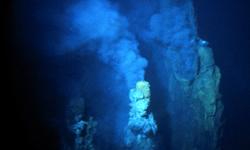 ©2020 Biological and Chemical Oceanography Data Management Office.
©2020 Biological and Chemical Oceanography Data Management Office.Funded by the U.S. National Science Foundation
Collaborative Research: Function, activity, and adaptation of microbial communities in geochemically diverse subseafloor habitats
The integration of both laboratory and field-based chemical and microbiological measurements into a quantitative predictive framework is crucial to understanding the microbial ecology of marine systems. This project work will provide a quantitative assessment of the functional diversity, activity, and physiological adaptation of microbial communities in geochemically diverse subseafloor habitats. Results will guide development of models for linking biogeochemical processes with particular microbial communities at deep-sea hydrothermal vents, with implications for other marine habitats as well. The focus of the effort is at Axial Seamount, a well-studied, active, deep-sea hydrothermal seamount in the NE Pacific Ocean. Samples already collected from Axial, along with a field program in Year 2, will serve as the foundation for the three objectives, which are to:
1. Determine and quantify the functional diversity and activity (expression) of key subseafloor microbial lineages at Axial Seamount.
2. Determine physiological adaptations to the subseafloor habitat by quantifying the growth response of Axial Seamount isolates to in-situ geochemical parameters.
3. Develop a quantitative predictive framework for linking particular types of geochemical vent conditions with specific microbial functional groups and activities at Axial Seamount.
Specific outcomes of this project include the creation of a comprehensive quantitative microbiological and chemical dataset on diffuse and adjacent high-temperature vents within Axial Seamount. This database will include chemical measurements (gases, nutrients, metals, isotopes, and calculated Gibbs free energies) relevant to microbial metabolic processes that can be compared to microbiological data (abundance and activity of microbial lineages and functional genes, growth rates of subseafloor isolates at relevant environmental conditions) using statistical analysis to identify how specific microbial activity is linked to the geochemical environment. This project builds on previous studies of microbial population structure and geochemical measurements at Axial Seamount and addresses critical gaps in current knowledge and understanding that are impeding progress of modeling hydrothermal systems. Results will increase understanding of deep-sea hydrothermal ecosystems as well as provide new insights into controls on the distribution and activity of marine microbial communities throughout the world's oceans.

Principal Investigator: David A. Butterfield
University of Washington (UW)
Principal Investigator: Julie Huber
Marine Biological Laboratory (MBL)
Co-Principal Investigator: Allison Beauregard Schwartz
Northwest Florida State College (NWFSC)